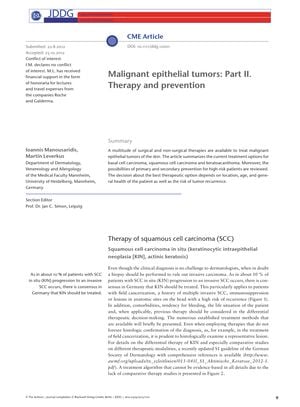Malignant Epithelial Tumors: Part II. Therapy and Prevention
January 2013
in “
Journal der Deutschen Dermatologischen Gesellschaft
”

TLDR The document concludes that individualized treatment for malignant epithelial tumors is necessary and more research on metastatic squamous cell carcinoma treatments is needed.
The document from 2013 provides an overview of treatments for malignant epithelial tumors such as basal cell carcinoma (BCC), squamous cell carcinoma (SCC), and keratoacanthoma (KA), as well as prevention strategies. It recommends excision with histological control of margins for invasive SCC, with varying safety margins based on risk assessment. For high-risk SCC, radiotherapy and EGFR inhibitors are alternatives, and chemotherapy options for metastatic SCC include methotrexate, cisplatin, 5-FU, taxanes, and gemcitabine, with targeted therapies like cetuximab showing promise. BCC is primarily treated with surgery, with less invasive methods for low-risk cases and radiotherapy for inoperable cases. Vismodegib, a sonic hedgehog signaling pathway inhibitor, is effective for advanced BCC but causes side effects like alopecia. KA can be managed with follow-up or excision, and intralesional therapies are also options. Prevention includes sunscreen use, systemic retinoids for high-risk patients, and HPV vaccines to prevent HPV-related malignancies. The document highlights the need for individualized treatment and more studies on metastatic SCC treatments.




